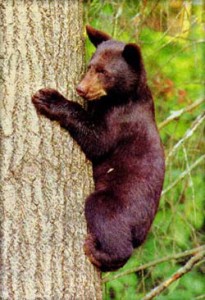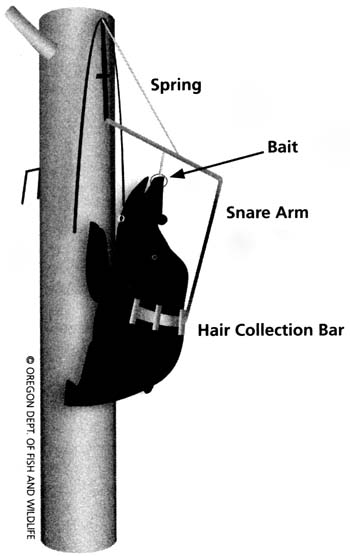Black Bear Census Set to Begin: Park to Estimate Population Using Hair Samples and DNA
Reflections Visitor Guide
Crater Lake National Park
Summer/Fall 2009
National Park Service
How many black bears live in Crater Lake National Park? Right now, your guess is as good as anyone’s! While park visitors and staff experience occasional sightings, nobody knows how many black bears (Ursus americanus) actually call the park home. This summer, however, the park’s newly established wildlife program will attempt to answer this question by gathering samples of black bear hair from across the park and analyzing the DNA within the hair.
Greg Holm is the park’s new (and first-ever) wildlife biologist. Holm, who holds a masters degree in Zoology from the University of Wyoming, has spent years studying and managing bears. This July and August, Holm and three summer employees will attempt to capture hair from each of the park’s resident bears using a “bear hair snare” technique developed by the Oregon Department of Fish and Wildlife.
 Biologist Holm and his staff plan to assemble 120 snares and place them throughout the park according to a grid system. Since female black bears in this part of Oregon are believed to have a home range of roughly 1.7 square miles (4.4 square km), the crew will need to distribute enough snares so that at least one is located in every potential home range. (Male black bears have a larger home range, typically patrolling an area 2 to 3 times that of females.)Funding for the project comes, in part, through purchases made by the public in the park’s visitor centers. The Crater Lake Natural History Association, a non-profit organization that operates the visitor center bookstores, has donated $4,500 from bookstore sales to buy materials needed to construct the snares.
Biologist Holm and his staff plan to assemble 120 snares and place them throughout the park according to a grid system. Since female black bears in this part of Oregon are believed to have a home range of roughly 1.7 square miles (4.4 square km), the crew will need to distribute enough snares so that at least one is located in every potential home range. (Male black bears have a larger home range, typically patrolling an area 2 to 3 times that of females.)Funding for the project comes, in part, through purchases made by the public in the park’s visitor centers. The Crater Lake Natural History Association, a non-profit organization that operates the visitor center bookstores, has donated $4,500 from bookstore sales to buy materials needed to construct the snares.
The crew will attach each snare to a tree trunk, 8 to 10 feet (2.4 to 3 meters) off the ground, then dangle from it a packet of scented, long-lasting bait. Bears, with their excellent sense of smell, will be lured to the trees and begin to climb. When a bear pulls at the bait, a hair-collection bar will be pulled down onto its back. The snare won’t injure or trap the bear, but as the bear descends the tree, carpet tacks embedded in the hair collection bar will snag bits of fur. “It’s like dragging a comb up the animal’s back,” describes Holm.
After two weeks, Holm’s crew will return to all 120 sites. For each snare visited by a bear, they will collect the residual fur with forceps, put it in an envelope, and reset the hair snare contraption. Over the course of the summer, they wiIl sample each site three times. At summer’s end, Holm will ship the hair to a genetics lab, which, through DNA analysis, should be able to determine the number of individual bears that “donated” hair to the study.
In addition to helping estimate the abundance of bears in the park, the survey will provide information about the bears’ distribution. Holm suspects that more bears will be found utilizing the wetter, western side of the park than the drier, eastern side, due to the greater presence and variety of shrubs. Black bears are omnivores but feed mainly on vegetation, such as berries. It’s likely that the results of the census will also raise new questions, helping to direct future research efforts.
So, if you’re wondering how many black bears live in Crater Lake National Park, check back next summer. In the meantime, take a piece of paper and write down your guess, so that you can compare it with our results.
 Other pages in this section
Other pages in this section- Government will buy $1 million of land in Siskiyou monument – October 30, 2009
- OIT Environmental Science Students Learn at Crater Lake – Oct. 22, 2009
- Three missing people found: hunters, mushroom hunter located Saturday – October 18, 2009
- Crater Lake Wilderness: Oregon’s ‘best idea’ needs protection – October 17, 2009
- Wet weather ends fire season around region – October 13, 2009
- Roosevelt historian: He was a ‘thinker’; Brinkley will share stories from new book inaugural lecture – October 12, 2009
- Prescribed burn postponed at Crater Lake: Park Service to wait until forecasts are more favorable – October 9, 2009
- Prescribed burns set for next few months: Agencies will burn nearly 15,000 acres, mostly in Jackson, Josephine counties – October 9, 2009
- Search exercise to cover area where boy was lost – September 11, 2009
- National Park Service Announces Appointment of Dr. Gary Machlis as Science Advisor to the Director – August 12, 2009
- Extra pair pays off in Crater Lake Rim Runs – August 9, 2009
- Wilderness proposed at Crater Lake – August 07, 2009
- Oregon Wild warns legal action on Crater Lake helicopters – August 6, 2009
- Cantwell: Jarvis Well-Qualified for the ‘Greatest Job in the World’ – July 28, 2008
- Senator Wyden issues statement condemning Crater Lake National park helicopter tours – July 27, 2009
- Desert Ridge Wildland Fire continues burning at Crater Lake National Park – July 21, 2009
- Whitney Wildland Fire nears containment at Crater Lake National Park – July 21, 2009
- Cameron (Cam) Sholly has been selected as the new superintendent of Natchez Trace Parkway – July 15, 2009
- Rep. Dicks supports Jon Jarvis for nomination of National Park Service Director – July 10, 2009
- USGS volcanologist Charles Bacon gives Mount Mazama geologic history talk – June 23, 2009
- USGS volcanologist Charles Bacon receives award at Crater Lake National Park – July 8, 2009
- Review: Geologic Map of Mount Mazama and Crater Lake Caldera, Oregon by Charles R. Bacon – July 7, 2009
- Free entrance weekends at Crater Lake National Park – June 20, 2009
- Oregon Congressman Proposes “Aerial Gondola” to Wizard Island – Summer/Fall 2009
- Lichen Survey Hits the Jackpot One-Day “BioBlitz” Uncovers 61 Species Not Previously Recorded at Crater Lake – Summer/Fall 2009
- A Conversation with the Park’s Chief of Terrestrial Ecology – Summer/Fall 2009
- A promise fulfilled on roadless forests – May 28, 2009
- Crater Lake Lodge opens for 2009 season – May 21, 2009
- Marcella Isabella Stine (1918 – 2009) – May 22, 2009
- Lawrence Campbell Merriam Jr. (1923 – 2008) – May 22, 2009
- Wayne R. Howe: 1920 – 2008 – May 21, 2009
- Passing of John Bowdler (1925 – 2009) – May 4, 2009
- Parks receive stimulus funds: Crater Lake, Lava Beds to use funding for improvements – April 24, 2009
- Mercy Flights makes life-saving donation to Crater Lake park – February 24, 2009
- Rescue at Crater Lake: specialized rescue team saves man from icy slope – February 2, 2009
- Former National Park Service director George B. Hartzog Jr. dies – January 31, 2009
- Ski patrol member watches over park: Niel Barrett is a charter member of the ski patrol at Crater Lake National Park – January 30, 2009
- Paradise in Blue: Snowshoe trek at Crater Lake informative, easy, free – January 22, 2009

